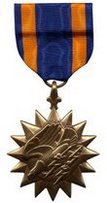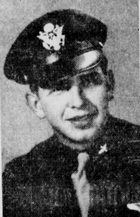Les Palmer
Ballplayers Wounded in Combat
| Date and Place of Birth: | May 20, 1923 Hitchcock, TX |
| Date and Place of Death: | October 23, 2009 Marshall, TX |
| Baseball Experience: | Minor League |
| Position: | Outfield |
| Rank: | Second Lieutenant |
| Military Unit: | 440th Bomb Squadron, 319th Bomb Group US Army Air Force |
| Area Served: | Mediterranean Theater of Operations |
Leslie L. "Les" Palmer, the son of D. T. and Meta Palmer, was born on
May 20, 1923, in Hitchcock, Texas. He graduated from Aransas Pass High
School in 1941, where he was a standout in football, basketball and
track. He played baseball with an American Legion team and attracted a
lot of attention, before entering Texas A&M College. In 1942, he signed
with the Lamesa Dodgers of the Class D West Texas-New Mexico League, and
played 53 games, batting .309.
Palmer enlisted with the Army Air Corps in September 1942, and was
called for duty January 26, 1943. He took basic training at Sheppard
Field, Texas, before being assigned to the 84th Air Crew Detachment at
Kansas State Teachers College in Emporia, Kansas. After two months, he
joined Squadron 113, Flight C, at the San Antonio Aviation Cadet Center,
Texas. In July 1943, he was transferred to Ellington Field, Texas. He
received his gunner's wings, completing the flexible aerial gunnery
course as part of Squadron L at Laredo Army Air Field, and graduated as
a bombardier, receiving his commission February 26, 1944, at Cadet Area
No. 2 at Childress Army Air Field, Texas.
served as a second lieutenant with the 440th Bomb Squadron, 319th Bomb
Group, in the Mediterranean Theater, flying from bases at Sardinia and
Corsica, from July 1944. At around 2:15pm, on October 19, 1944, on
Palmer's 20th mission, his Martin B-26 Marauder bomber was shot down on
a mission to Mantua, Italy.
and he was wounded, suffering second degree burns to his face, and
captured. He spent the next six months as a prisoner of war in Stalag
VII-A, located just north of the town of Moosburg in southern Bavaria,
the first two months at the Reserve Lazarett POW hospital at Freising.
and it was not until early December 1944, that his family received
confirmation he was a prisoner. Prior to that he was reported as missing
in action.
On the morning of January 8, 1945, following a heavy RAF raid the night
before, Palmer wrote the following from the Reserve Lazarett Freising
POW hospital at Freising:
I stood at my hospital window
And watched the raid from afar;
I saw a plane go down blazing -
Very like a falling star.
My thoughts turned to the gallant crew
And wondered if any were still aboard
As only another flyer could do -
For surely their bombs had scored.
And if any did go down,
There's a fact I know very well -
They went to an airman's Heaven
And not a flak gunner's hell.
To not fly, but to be in Heaven,
"Sure" they said, "we'll give it a go."
So when met at the gate by St. Peter, he said,
"Nice work, chaps; bloody fine show."
In March 1945, his parents received a letter from an RAF pilot who had
been a POW with Palmer:
Dear Mr. and Mrs. Palmer:
I have just been repatriated from Germany and while at Stalag VII was
with your son Les...although both of different nationalities it made not
the slightest difference, only emphasizing the common bond between our
two countries.
He asked me to write and let you know that he is still going strong and
in the very best of spirits. In fact he is so well now that he seems to
devote the major part of his time to thinking out schemes whereby he may
stay in the hospital.
Although in hospital you have no need to worry, there is a very able
medical staff there - British, American, French, Polish and German
doctors and numerous medical orderlies of the same nationalities, so you
can see medical attention is good.
Food parcels, games and medical supplies are coming through in
reasonable quantities from the Red Cross at Geneva. When I left mail had
not come through to us in Germany, although it was expected any day...it
is mostly the fault of the RAF and US AAC. Knowing les, you will
appreciate his thought on this subject, which naturally goes for all the
boys in captivity.
Best wishes,
Sgt. M. J. Clayton
Totton, Southampton, England
Palmer was liberated on April 29, 1945. He was back in the United States
by June 1945, and was discharged from Camp Kilmer, New Jersey. In
January 1946, he was awarded the Purple Heart and Air Medal with
cluster.
Palmer went back to study at Texas A&M College, and during that time he
played softball with the Texas Aggies. Graduating in 1948, his attention
returned to baseball and he signed with the Odessa Oilers of the Class D
Longhorn League. Palmer played 137 games and batted .333, setting a
league record with 21 triples. Back with Odessa in 1950, he batted .297
in 73 games and hit 20 home runs. In 1951, he batted .336 with the the
Oilers in 76 games, and concluded his professional career, aged 29, with
the Roswell Rockets of the Longhorn League in 1952, batting .318 in 84
games.
Palmer had continued his studies throughout this time. He received his
Masters of Education in 1951, and in 1953, he was the Aetna Fellow at
New York University's Center for Safety Education. Additional doctoral
studies were done at The University of Texas-Austin, Baylor University,
Texas Tech University and Texas A&M, where he was an assistant baseball
coach and a freshman coach. Palmer also worked as a scout for the
California Angels.
During his tenure at A&M, he authored books on safety education,
baseball (Baseball Fundamentals for Fathers and Sons; with Wally Moon
and Al Monchak), softball and bowling. He retired as Assistant
Department Head of Health and Kinesiology. In 2006, he was elected to
the Aransas Pass Hall of Fame, and was honored by Texas A&M with the
annual Les Palmer Invitational Golf Tournament. The Les Palmer Dressing
Room at Olsen Field, home of A&Ms baseball team, was named in his honor.
Les Palmer passed away on October 23, 2009, in Marshall, Texas. He was
86 years old and is buried at Arlington National Cemetery in Virginia.
Date Added February 3, 2018
Can you add more information to this biography and help make it the best online resource for this player? Contact us by email
Read Baseball's Greatest Sacrifice Through The Years - an online year-by-year account of military related deaths of ballplayers
Baseball's Greatest Sacrifice is associated with Baseball Almanac
Baseball's Greatest Sacrifice is proud to be sponsored by



